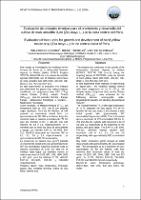Mostrar el registro sencillo del ítem
Evaluación de unidades térmicas para el crecimiento y desarrollo del cultivo de maíz amarillo duro (Zea mays, L.) en la costa central del Perú
| dc.contributor.author | Yzarra Tito, Wilfredo Julián | |
| dc.contributor.author | Trebejo, Irene | |
| dc.contributor.author | Noriega Nalvarte, Víctor | |
| dc.date.accessioned | 2021-07-06T16:05:36Z | |
| dc.date.available | 2021-07-06T16:05:36Z | |
| dc.date.issued | 2009 | |
| dc.identifier.uri | https://hdl.handle.net/20.500.12542/1079 | |
| dc.description.abstract | Este trabajo de investigación fue realizado en los terrenos del fundo de la Universidad Nacional Agraria, La Molina (latitud 12º05’S, longitud 76º57’W, altitud 238 m.s.n.m) durante la campaña agrícola 2007/2008, con 06 híbridos comerciales de maíz amarillo duro (DK-5005; AG-001; XB8010; C-701; PM-212; EXP-10 ). En este experimento se evaluaron tres métodos para determinar los grados días: método residual modificado con temperatura base 10ºC (TT10), método Ontario (C.H.U), método Ometto (GDOmetto), para los períodos Siembra - Espiga, Espiga - Maduración Fisiológica y Siembra – Maduración Fisiológica. Como resultado, el Método Residual (TT10), con temperatura base de 10ºC, fue el que presento mejor resultados. Para los 06 híbridos, el IAF presentó un crecimiento inicial lento con aproximadamente 387 GD acumulados, luego fue creciente hasta un máximo acumulado de 773 GD para los híbridos C-701 y AG-001 con IAF máximo de 3,8 y 3,2, respectivamente, en el momento que se inicio las fases de panojamiento y espiga. Los híbridos EXP-10, DK-5005, PM212, XB-8010 alcanzaron sus máximos IAF de 4,1; 3,1; 3,9 y 2,9 respectivamente, con aproximadamente 882 GD acumulados. La producción de materia seca (gr/m2 ) presentó un crecimiento inicial lento con aproximadamente 387 GD acumulados, luego fue creciente hasta un máximo acumulado de 1241 GD para los 06 híbridos hasta lograr sus máximos valores de materia seca total de 1525, 987, 1540, 1388, 1693, y 923 g/m2 , para los híbridos C-701, AG-001 EXP-10, DK-5005, PM-212 y XB-8010 respectivamente. | es_PE |
| dc.description.abstract | This research was conducted on the parcels of the Universidad Nacional Agraria La Molina (12º05’S, 76º57’W, 238 m.a.s.l.) during the cropping season of 2007/2008, using six hybrids of hard yellow maize (DK-5005; AG-001; XB8010; C-701; PM-212; EXP-10 ). In this experiment three methods of determining of degree-days - the modified residual method with base temperature of 10 ºC (TT10), the Ontario method (Crop Heat Unit) and the Ometto method (DDOmetto) - were evaluated for the following seasons: sowing-spike, spikephysiological maturity and planting-physiological maturity. The residual method (TT10) with base temperature of 10 ºC presented the best results. For all six hybrids the leaf area index (LAI) showed a slow initial growth with approximately 387 accumulated degree-days (DD). Then it increased up to a maximum of 773 accumulated DD for C701 and AG-001 hybrids with maximum LAI of 3,8 and 3,2 respectively at the beginning of the panicle and tassel stage. The EXP-10, DK 5005, PM-212, XB-8010 hybrids reached their maximum LAI of 4.1, 3.1, 3.9 and 2.9 respectively with approximately 882 accumulated DD. Dry matter production (g/m2) showed an initial slow growth with approximately 387 accumulated DD. Then it increased up to a maximum of 1241 accumulated DD for six hybrids, until they achieved their maximum values of total dry matter of 1525, 987, 1540, 1388, 1693 and 923 g/m2, for C-701, AG-001 EXP-10, DK-5005, PM-212 and XB-8010 hybrids respectively. | en_US |
| dc.format | application/pdf | es_PE |
| dc.language.iso | spa | es_PE |
| dc.publisher | Servicio Nacional de Meteorología e Hidrología del Perú | es_PE |
| dc.relation.uri | https://web2.senamhi.gob.pe/rpga/pdf/2009_vol01/art1.pdf | es_PE |
| dc.rights | info:eu-repo/semantics/openAccess | es_PE |
| dc.rights | Atribución-NoComercial-SinDerivadas 3.0 Estados Unidos de América | * |
| dc.rights.uri | http://creativecommons.org/licenses/by-nc-nd/3.0/us/ | * |
| dc.source | Repositorio Institucional - SENAMHI | es_PE |
| dc.source | Servicio Nacional de Meteorología e Hidrología del Perú | es_PE |
| dc.subject | Cultivo--Maíz | es_PE |
| dc.subject | Zonas Costeras | es_PE |
| dc.subject | Temperatura | es_PE |
| dc.title | Evaluación de unidades térmicas para el crecimiento y desarrollo del cultivo de maíz amarillo duro (Zea mays, L.) en la costa central del Perú | es_PE |
| dc.title.alternative | Evaluation of heat units for growth and development of hard yellow maize crop (Zea mays L.) in the central coast of Peru. | es_PE |
| dc.type | info:eu-repo/semantics/article | es_PE |
| dc.identifier.journal | Revista Peruana Geo-Atmosférica | |
| dc.subject.ocde | https://purl.org/pe-repo/ocde/ford#4.01.01 | es_PE |
| dc.publisher.country | PE | es_PE |
| dc.identifier.url | https://hdl.handle.net/20.500.12542/1079 |









